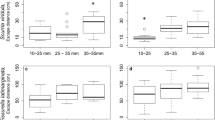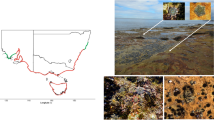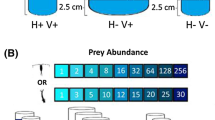Summary
We examined predator avoidance behavior of the freshwater snailPhysella (=Physa) virgata in response to the crayfishProcambarus simulans. In both laboratory and field enclosure experiments snails crawled above the waterline for 2 h or longer, then returned to the water.Physella virgata react to chemical signals given off by crayfish actively foraging on conspecific snails; they do not react to inactive crayfish. Low dissolved oxygen, crowding, and disturbance of the sediments did not elicit “crawlout” behavior. Crawling above the waterline, by reducing the probability of encounter between vulnerable, thin-shelled snails and crayfish, is an adaptive response to predation.
Similar content being viewed by others
References
Alexander JE Jr (1987) Predator-prey interactions between fresh-water snails and crayfish. Ph.D. dissertation, University of Oklahoma
Alexander JE Jr, Covich AP (1991) Predation risk and avoidance behavior in two freshwater snails. Biol Bull, in press
Ansell AD (1969) Defensive adaptations to predation in the mollusca. Proc Mar Biol Assoc India Symp Series 3:487–512
Bertness MD, Garrity SD, Levings SC (1981) Predation pressure and gastropod foraging: a tropical-temperate comparison. Evolution 35:995–1007
Blundon JA, Vermeij GJ (1983) Effect of shell repair on shell strength in the gastropodLittorina irrorata. Mar Biol 76:41–45
Bronmark C, Malmqvist B (1986) Interactions between the leechGlossiphonia complanta and its gastropod prey. Oecologia 69:268–276
Brown KM (1979) The adaptive demography of four freshwater pulmonate snails. Evolution 33:417–432
Brown KM (1982) Resource overlap and competition in pond snails: an experimental analysis. Ecology 63:412–422
Brown KM, DeVries DR (1985) Predation and the distribution and abundance of a pulmonate pond snail. Oecologia 66:93–99
Brown KM, Strouse BH (1988) Relative vulnerability of six fresh-water gastropods to the leechNephelopsis obscura (Verrill). Freshwater Biol 19:157–165
Clampitt PT (1970) Comparative ecology of the snailsPhysa gyrina andPhysa integra (Basommatophora: Physidae). Malacologia 10:113–151
Covich AP (1981) Chemical refugia from predation for thin-shelled gastropods in a sulfide-enriched stream. Verh Int Ver Theor Angew Limnol 21:1632–1636
Covich AP, Knezevic B (1978) Size-selective predation by fish on thin-shelled gastropods (Lymnaea); the significance of floating vegetation (Trapa) as a physical refuge. Verh Int Ver Theor Angew Limnol 20:2172–2177
Croll RP (1983) Gastropod chemoreception. Biol Rev 58:293–319
Crowl TA (1989) Direct and indirect effects of crayfish (Orconectes virilis) predation on snail (Physella virgata virgata) population dynamics in spring-fed streams. Ph.D. dissertation, University of Oklahoma
Crowl TA, Alexander JE Jr (1989) Parental care and foraging ability in male waterbugs (Belostoma flumineum). Can J Zool 67:513–515
Crowl TA, Covich AP (1990) Predator-induced life-history shifts in a freshwater snail. Science 247:949–951
DeWitt RM (1955) The ecology and life history of the pond snailPhysa gyrina. Ecology 36:40–44
Feder HM (1963) Gastropod defensive responses and their effectiveness in reducing predation by starfishes. Ecology 44:505–512
Hanson JM, Chambers PA, Prepas EE (1990) Selective foraging by the crayfishOrconectes virilis and its impact on macroinvertebrates. Freshwater Biol 24:69–80
Hubbs C (1990) Snails as a food source forGambusia. Texas J Sci 42:245–256
Hughes RN (1986) A Functional Biology of Marine Gastropods. The Johns Hopkins University Press, Baltimore, Maryland
Kerfoot WC, Sih A (eds) (1987) Predation: Direct and Indirect Impacts on Aquatic Communities. University Press of New England, Hanover, New Hampshire
Kesler DK, Munns WR Jr (1989) Predation byBelostoma flumineum (Hemiptera): an important cause of mortality in fresh-water snails. JN Am Benthol Soc 8:342–350
Kohn AJ (1961) Chemoreception in gastropod molluscs. Am Zoologist 1:291–308
Lodge DM, Brown KM, Klosiewski SP, Stein RA, Covich AP, Leathers BK, Bronmark C (1987) Distribution of freshwater snails: spatial scale and the relative importance of physicochemical and biotic factors. Am Malacol Bull 5:73–84
Lowell RB (1986) Crab predation on limpets: predator behavior and defensive features of the shell morphology of the prey. Biol Bull 171:577–596
McMahon RF (1975) Effects of artificially-elevated water temperatures on the growth, reproduction and life cycle of a natural population ofPhysa virgata Gould. Ecology 56:1167–1175
McMahon RF (1983) Physiological ecology of freshwater pulmonates. In: Russell-Hunter WD (ed) The Mollusca. Vol. 6. Ecology. Academic Press, Inc., Orlando, Florida, pp 359–430
Palmer AR (1979) Fish predation and the evolution of gastropod shell sculpture: experimental and geographic evidence. Evolution 33:697–713
Peckarsky BL (1984) Predator-prey interactions among aquatic insects. In: Resh VH and Rosenberg DM (eds) The Ecology of Aquatic Insects. Praeger Publications, New York, pp 196–254
Phillips DW (1976) The effect of a species-specific avoidance response to predatory starfish on the intertidal distribution of two gastropods. Oecologia 23:83–94
Phillips DW (1977) Avoidance and escape responses of the gastropod molluscsOlivella biplicata (Sowerby) to predatory asteroids. J Exp Mar Biol Ecol 28:77–86
Phillips DW (1978) Chemical mediation of invertebrate defensive behaviors and the ability to distinguish between foraging and inactive predators. Mar Biol 49:237–243
Schmitt RJ (1982) Consequences of dissimilar defenses against predation in a subtidal marine community. Ecology 63:1588–1601
Sih A (1980) Optimal behavior: can foragers balance two conflicting demands? Science 210:1041–1043
Sih A (1982) Foraging strategies and the avoidance of predation by an aquatic insect,Notonecta hoffmanni. Ecology 63:786–796
Snyder NFR (1967) An alarm reaction of aquatic gastropods to intraspecific extract. Cornell Univ Agr Exp Stn Mem 403
Stein RA, Magnuson JJ (1976) Behavioral response of crayfish to a fish predator. Ecology 57:751–761
Townsend CR, McCarthy TK (1980) On the defence strategy ofPhysa fontinalis (L.), a freshwater pulmonate snail. Oecologia 46:75–79
Vaughn CC, Fisher FM (1988) Vertical migration as a refuge from predation in intertidal marsh snails: a field test. J Exp Mar Biol Ecol 123:163–176
Vermeij GJ (1976) Interoceanic differences in vulnerability of shelled prey to crab predation. Nature 260:135–136
Vermeij GJ (1982a) Phenotypic evolution in a poorly dispersing snail after arrival of a predator. Nature 299:349–350
Vermeij GJ (1982b) Unsuccessful predation and evolution. Am Nat 120:701–720
Vermeij GJ, Covich AP (1978) Coevolution of freshwater gastropods and their predators. Am Nat 112:833–843
Virnstein RW (1977) The importance of predation by crabs and fishes on benthic infauna in Chesapeake Bay. Ecology 58:1199–1217
Werner EE, Hall DJ (1988) Ontogenetic habitat shifts in blue-gill: the foraging rate-predation risk trade-off. Ecology 69:1352–1366
Werner EE, Gilliam JF, Hall DJ, Mittelbach GG (1983) An experimental test of the effects of predation risk on habitat use in fish. Ecology 64:1540–1548
Wilbur KM, Saleuddin ASM (1983) Shell formation. In: Saleuddin ASM, Wilbur KM (eds) The Mollusca. Vol. 4. Physiology, Part 1. Academic Press, New York, pp 235–287
Author information
Authors and Affiliations
Rights and permissions
About this article
Cite this article
Alexander, J.E., Covich, A.P. Predator avoidance by the freshwater snailPhysella virgata in response to the crayfishProcambarus simulans . Oecologia 87, 435–442 (1991). https://doi.org/10.1007/BF00634603
Received:
Accepted:
Issue Date:
DOI: https://doi.org/10.1007/BF00634603




